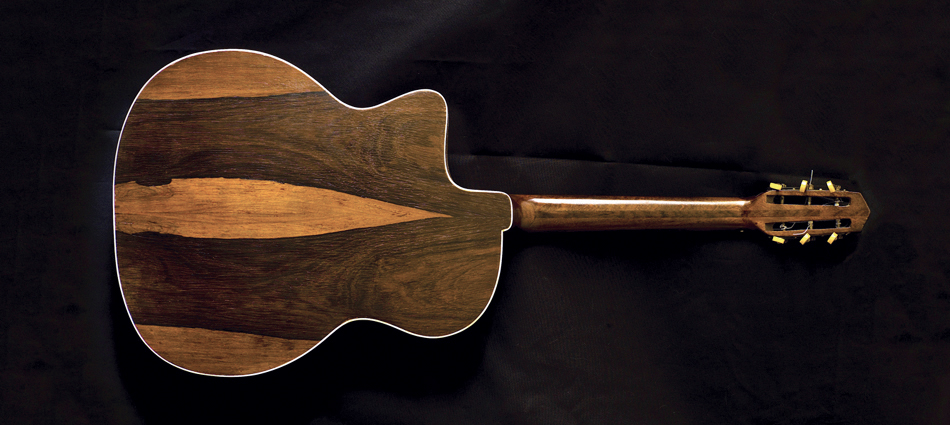Francesco Olivieri è stato un importante liutaio di scuola romana dei primi del 900. Da Roma si trasferì in Sicilia, a Catania, e intorno agli anni 40 emigrò a Parigi, continuando a costruire chitarre, mandolini e banjo, finchè non scopri la Selmer-Maccaferri, la chitarra con la caratteristica buca ovale usata dal grande zingaro/jazzista Django Rheinhardt. Olivieri ne semplificò il complicato gioco di incatenature del piano armonico, impiegando per realizzare le sue chitarre di stile “Manouche” (zingaro) legni particolarmente pregiati. Il modello che analizziamo qui contiene tutte le innovazioni di Olivieri: invece che in abete, la tavola è in cedro rosso del Libano, è tutta bordata da trapezi in osso, mentre il battipenna è in celluloide nera con intarsi in madreperla che rappresentano delle cetre. Le fasce e il fondo sono tratte da un meraviglioso taglio di legno brasiliano jakaranda: il retro della cassa, splendidamente fiammato, ricorda un quadro di Braque.

Se questa chitarra costituisce uno dei pezzi più interessanti della mia collezione, il merito è del liutaio Leonardo Petrucci, che ogni tanto torna dai suoi viaggi a Parigi con qualche bella rarità. Leonardo suona anche chitarra e mandolino nella mia band “BJG roots music”, e così ho spesso occasione di conoscere da vicino ( e quando posso, fare miei) alcuni degli strumenti del passato di cui si occupa. Recentemente ha esposto a Sarzana una delle sole sei chitarre costruire da Antonio Stradivari: inarrivabile!
-------
In the early 1900s, Francesco Olivieri was an important luthier from the Roman school. From Rome he moved to Catania in Sicily, then around the 1940s he emigrated to Paris, and kept building guitars, banjos and mandolins until he discovered the Selmer-Maccaferri, a guitar characterized by the typical oval hole and used by the great gipsy jazz musician Django Reinhardt. Olivieri simplified the complex set of interconnections in the soundboard, creating his “Manouche” (gipsy-style) guitars with especially valuable woods.
Today’s piece includes all Olivieri’s innovations: the soundboard is in red Lebanon cedar instead of fir, enveloped by bone trapezoids, while the pickguard is made out of black celluloid inlaid with lyre-shaped mother-of-pearl inserts. The bands and the bottom are made out of a wonderful cut of Brazilian Jakaranda wood; the back, beautifully decorated with flames, is reminiscent of a Braque painting. I owe this uniquely interesting piece of my collection to the luthier Leonardo Petrucci, who occasionally returns from his Paris trips with some nice rarity. Leonardo plays guitar and mandolin in my band “BJG roots music” and so I often have the opportunity to learn aboout – and occasionally acquire – some of the historical instruments he deals with. Recently he exhibited in Sarzana one of only six guitars built by Antonio Stradivari: unattainable!